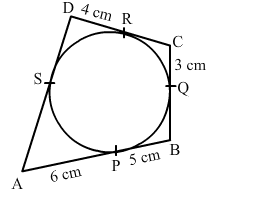In the given figure, quadrilateral ABCD is circumscribed, touching the circle at P, Q, R and S. If AP = 6 cm, BP = 5 cm, CQ = 3 cm and DR = 4 cm, then the perimeter of quadrilateral ABCD is

(a) 18 cm
(b) 27 cm
(c) 36 cm
(d) 32 cm
(c) $36 \mathrm{~cm}$
Given, $A P=6 \mathrm{~cm}, B P=5 \mathrm{~cm}, C Q=3 \mathrm{~cm}$ and $D R=4 \mathrm{~cm} .$
$\mathrm{T}$ angents drawn from an external points to a circle are equal.
So, $\mathrm{AP}=\mathrm{AS}=6 \mathrm{~cm}, \mathrm{BP}=\mathrm{BQ}=5 \mathrm{~cm}, \mathrm{CQ}=\mathrm{CR}=3 \mathrm{~cm}, \mathrm{DR}=\mathrm{DS}=4 \mathrm{~cm} .$
$\therefore \mathrm{AB}=\mathrm{AP}+\mathrm{PB}=6+5=11 \mathrm{~cm}$
$\mathrm{BC}=\mathrm{BQ}+\mathrm{CQ}=5+3=8 \mathrm{~cm}$
$\mathrm{CD}=\mathrm{CR}+\mathrm{DR}=3+4=7 \mathrm{~cm}$
$\mathrm{AD}=\mathrm{AS}+\mathrm{DS}=6+4=10 \mathrm{~cm}$
$\therefore$ Pe rimeter of qua drilateral $\mathrm{ABCD}=\mathrm{AB}+\mathrm{BC}+\mathrm{CD}+\mathrm{DA}$
$=(11+8+7+10) \mathrm{cm}$
$=36 \mathrm{~cm}$
